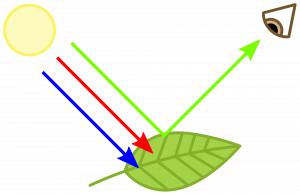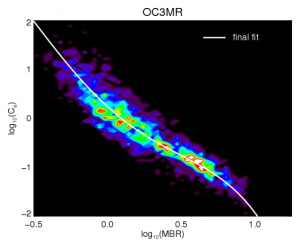60 Reflectance and ocean color
When light encounters a boundary, such as sunlight incident on the ocean surface, some is reflected and some is transmitted. The reflected light appears white to our eye – we give it the name sun glint, or more technically, specular reflection.
Light transmitted through the air-sea interface is scattered off particles in the water, resulting in energy moving in all directions over 360°. The energy backscattered toward the ocean surface can pass back into the atmosphere, reaching your eye or a satellite sensor.

In addition, discrete wavelengths of light may be absorbed by different kinds of molecules. The most common photosynthetic pigment, chlorophyll, absorbs both blue and red wavelengths of light, giving plants their characteristic green color. Water itself preferentially absorbs red wavelengths. Because of absorption, light that has been scattered off particles in the upper ocean and re-transmitted into the air will have a different spectrum than the incident light, and thus the ocean will be identified as having a certain color. For example, open-ocean regions appear more blue than coastal regions, where phytoplankton concentration is greater, and more blue light is absorbed.
The percentage of incident light directed upward from the surface of the ocean is called the reflectance (regardless of whether it was reflected or re-transmitted). Satellites have sensors designed to measure reflectance at specific wavelengths of light. The ratio of intensity at blue vs green wavelengths can be empirically correlated with the chlorophyll concentration of water samples to develop an “ocean color” proxy for primary productivity in the ocean.

After correction for atmospheric effects, the algorithm identifies a maximum band ratio (MBR), the largest ratio of intensity at several possible blue wavelengths divided by intensity at a green wavelength. Then, a nonlinear fit (specific for each satellite) is made between the MBR and available in-situ chlorophyll-a concentration data.
While current satellites are limited to measuring reflectance at a few discrete wavelengths, NASA’s next-generation ocean color satellite PACE (Plankton, Aerosol, Cloud, and ocean Ecosystem) will be capable of hyperspectral resolution, meaning it will be capable of measuring at enough wavelengths to approximate the full spectrum of light, as well as ultraviolet and near-infrared bands.
Media Attributions
- Why_are_plants_green © Wikimedia: Nefronus is licensed under a CC BY-SA (Attribution ShareAlike) license
- ocdens_oc3mr © NASA: P. Jeremy Werdell is licensed under a Public Domain license

